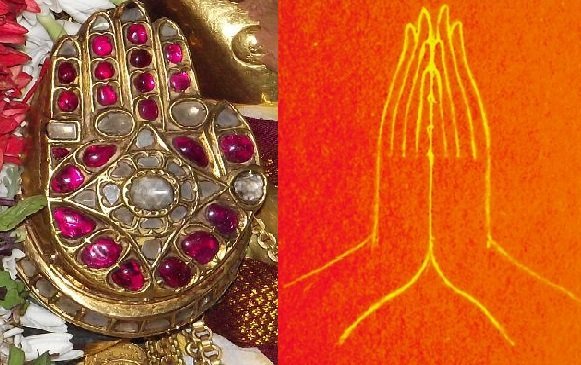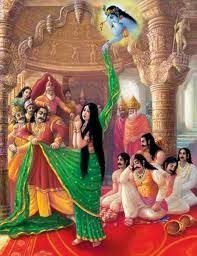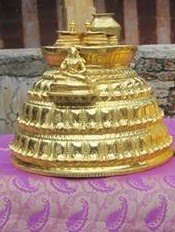srI vAnAchala mahAmunayE nama:
emperumAnAr explains to vangi puratthu nambi the obstacles that are faced by srIvaishNavas in various aspects of day-to-day life. vangi puratthu nambi
documents these instructions in a wonderful grantham with commentary
named virOdhi parihArangaL (removal of obstacles). We are now viewing
the English translation of this grantham with the help of the
explanations given by srI u. vE. V V Ramanujam swamy. The whole series
can be viewed at https://granthams.koyil.org/virodhi-pariharangal-english/.
anjali means saluting (namaskAram) with joined palms. This is related to 48th topic (vandhana – offering obeisances). After offering obeisances, one has to rise up and perform anjali (salute with joined palms). It is also seen that, at times, one just performs anjali without offering full obeisances. anjali is done by bring the hands to the chest and holding it in a way both the palms are touching each other. It is also seen that the palms are joined and held on top of the head at times. anjali is defined by “am jalayathi ithi anjali:” (அம் ஜலயதி இதி அஞ்ஜலி:) that which melts bhagavAn who is mentioned by “a” – akAram. It is also said that “anjali: paramAmudhrA kshipram dhEvaprasAdhinI” (அஞ்ஜலி: பரமாமுத்ரா க்ஷிப்ரம் தேவப்ரஸாதிநீ) – anjali is the ultimate and top-most posture which will quickly induce bhagavAn‘s mercy.

- anjali must be performed with our mind fixated on bhagavAn‘s lotus feet. It must not be performed with our mind focussed on others like dhEvathAnthrams, materially rich persons, etc.
- It must be understood that there is no time restrictions to perform anjali and performing anjali after checking for auspicious time, etc.
- Not understanding that it can be performed by and to any srIvaishNava (no need for any qualification) is an obstacle. Similarly, thinking that one needs special qualification to perform anjali is also not correct. Any one who has bhagavath sambandham can be offered anjali. We can recollect thirumangai AzhwAr‘s thirunedunthANdam pAsuram 14 “vaLarththathanAl
payan peRREn varugavenRu madakkiLiyaik kaikUppi vaNanginALE”
(வளர்த்ததனால் பயன் பெற்றேன் வருகவென்று மடக்கிளியைக் கைகூப்பி வணங்கினாளே) – even though the parrot was raised by parakAla nAyaki (thirumangai AzhwAr
in feminine mood), when she heard that parrot beautifully recite the
names of emperumAn, she feels greatly joyful and performs anjali with joined palms to
her own parrot. - Not understanding that one can perform anjali in any situation is an obstacle. In saraNAgathi gadhyam,
emperumAnAr says “EnakEnAbi prakArENa dhvayavakthA” (ஏநகேநாபி ப்ரகாரேண த்வயவக்தா) – In whichever situation, one recites dhvaya mahA manthram – similar to that, in any situation one performs anjali, that will melt emperumAn. - Not considering that one anjali is sufficient and thinking that one should perform multiple anjalis. sakruth – once. asakruth – multiple times. In ALavandhAr‘s sthOthra rathnam 28, he says to emperumAn “thvadhangri mudhdhichya kathApi kEnachith yathA thathA vApi sakruth kruthOnjali: thadhaiva mushNAthi asubAni asEshatha: subhAni pushNAthi najAthu hIyathE” (த்வதங்க்ரி முத்திச்ய கதாபி கேநசித் யதா ததா வாபி ஸக்ருத் க்ருதோஞ்ஜலி: ததைவ முஷ்ணாதி அசுபாநி அசேஷத: சுபாநி புஷ்ணாதி நஜாது ஹீயதே) – A single anjali performed by any one at any time in any way towards your lotus feet will at once remove the sins and increases the well-being of such person and never lets that goodness diminish. Thus, just performing anjali once is sufficient and no need to keep on repeating it. Translator’s note: bhattar beautifully reveals the glories of periya pirAttiyAr in his srI guNa rathna kOsam, 58th slOkam “iswaryam akshara gathim paramam padham vA kasmaichith anjali param vahathE vidhIrya asmai na kinchith uchitham krutham ithi atha amba thvam lajjasE kathaya ka: ayam udhArabhAva:” (ஐஸ்வர்யம் அக்ஷர கதிம் பரமம் பதம் வா கஸ்மைசித் அஞ்ஜலி பரம் வஹதே விதீர்ய அஸ்மை ந கிஞ்சித் உசிதம் க்ருதம் இதி அத அம்ப த்வம் லஜ்ஜஸே கதய க: அயம் உதாரபாவ:) – Dear mother! If one performs anjali in front of you, you bless him with worldly wealth, supreme destination (paramapadham) and kainkaryam in paramapadham. After giving everything, you are thinking ‘have I done enough?’ and puts her head down out of shyness. From this we can understand the mood of emperumAn and pirAtti, who cannot even bear the devotee taking the least effort in approaching them and are willing to shower their grace at once. So – what to speak of multiple efforts?
- Considering that performing an anjali will accomplish the desired result much later in the future and not understanding that result will be bestowed immediately. As said in “kshipram dhEva prasAdhinI” (க்ஷிப்ரம் தேவப்ரஸாதிநீ), bhagvAn at once bestows the desired result when seeing any one performing an anjali. This can also be understood from previous point of discussion.
- Considering that for each apachAram (offense) a separate anjali must be performed and not thinking that one anjali is sufficient to remove all apachArams. Just saying “aparAdhAnimAn sarvAn kshamasva purushOththama!” (அபராதாநிமாந் ஸர்வாந் க்ஷமஸ்வ புருஷோத்தம!) – Oh best among the AthmAs (bhagavAn)! Please forgive all my offenses and performing an anjali will be sufficient. Translator’s note: This reference is part of the slOkam “upachArApadhEsEna…“. This slOkam is recited at the end of our thiruvArAdhanam at home. It means “Oh bhagavAn! I started this thiruvArAdhanam with the desire to pamper you and serve you. But I ended up committing more offenses than service to you. So, you kindly forgive me for all such offenses”. Looking at the greatness of bhagavAn, one can never serve him sufficiently enough. Also, considering the mental state of jIvAthmAs who are bound in this samsAram, even while performing thiruvArAdhanam, it will be very difficult to fully focus on emperumAn alone and worship him properly. So, from both bhagavAn‘s greatness and jIvAthmA‘s imperfections, thiruvArAdhanam will only end up being an unsatisfactory one from jIvAthmA‘s perspective. But bhagavAn being the epitome of saulabhyam (simplicity), gracefully accepts whatever kainkaryam performed by his devotee with great joy even if there are some deficiencies.
- Similar to the previous point, anjali will not remove only certain pApams (sins) but it will remove all types of sins. It is called “sarvapApanivAraNi” (that which removes all sins). But there is no hope of upliftment for the persons who intentionally perform sins and plan to atone by performing anjali every time.
- Considering that performing anjali will only bestow certain auspiciousness and not all auspiciousness in full is an obstacle. As discussed previously in sthOthra rathnam 28th slOkam, it will bestow all auspiciousness.
- Performing anjali only until getting the desired result and not understanding that even after getting the result, one should continue performing anjali. This is focussed on bhagavath anubhavam as the result. Even in paramapadham, nithyas and mukthas are said to be performing anjali as in “nama ithyEva vAdhina:” (நம இத்யேவ வாதிந:). Translator’s note: nammAzhwAr says in thiruvAimozhi 3.8.4 “kaikaLAlARath thozhuthu thozhuthunnai” (கைகளாலாறத் தொழுது தொழுதுன்னை) – I am worshiping you constantly by performing anjali. nampiLLai‘s vyAkyAnam (commentary) is most excellent for this – his brilliance shines like a radiant sun in revealing AzhwAr’s divine emotions. He says nammAzhwAr‘s tendency for performing anjali is most dear to him. He says “One who is focussed on material benedictions will stop worshiping once their desire is fulfilled. One who performs as sAdhanam (means) to achieve something will stop once their goal is achieved. But for the one who has this as their yAthrA (life sustaining activity) as said in ‘nithyAnjali pudA:” (நித்யாஞ்ஜலி புடா:) for svEtha dhvIpa vAsis (the residents of milk ocean), (nithyas and) mutkthas in paramapadham too always perform anjali constantly as previously seen in ‘nama ithyEva vAdhina:‘”. He continues to explain that emperumAn sustains himself by inducing these great devotees perform anjali to him. So, we can understand that when done as kainkaryam out of great love and affection towards emperumAn, one keeps performing anjali.
- Not understanding that garuda mudhrA will control and subdue snake’s poison, this anjali mudhrA will control and subdue bhagavAn‘s svAthanthriyam (total independence/free-will). One must be very faithful of this principle. Translator’s note: In srI rAmAyaNa slOkam, “cha chAla chApam cha mumOcha vIra:” (ச சால சாபம் ச முமோச வீர)
– when rAvaNan was holding on to the bow and shooting arrows at srI rAma, srI
rAma was counter-attacking as well – but when rAvANa’s bow was broken by srI
rAma and he dropped it down (knowing well that srI rAma will not hit him if he does not have any weapons in his hands), srI rAma immediately stopped attacking rAvaNa and
gave him a life-line. Our pUrvAchAryas explain that, if only rAvaNa performed an anjali at that time, he would have easily won over srI rAma – since emperumAn can be controlled by this supreme mudhrA named anjali mudhrA. - One should firmly understand that just like abhaya hastham (protection posture) is apt for the nature of the sEshi (master), anjali hastham (joined palms posture) is apt for the nature of the sEsha bhUthan (servant). Not having such faith is an obstacle. sEshi – svAmi (master), i.e., emperumAn. He holds his hand in different postures such as abhaya hastham (giving protection posture), varadha hastham (bestowing posture), AhvAna hastham (inviting posture), etc. Similarly, for jIvAthmA, anjali hastham is the most apt one – since it reveals the jIvAthmA‘s ananya gathithvam (that there is no other refuge) and Akinchanyam (that he does not have anything in his hands). Translator’s note: We have already seen in the vyAkyAnam for thiruvAimozhi 3.8.4 pAsuram in previous points – emperumAn sustains himself by protecting his devotees and jIvAthmA sustains himself by accepting emperumAn‘s protection.

- Performing anjali with attachment to protecting oneself is an obstacle. By performing anjali, one manifests that there is nothing on ones own to protect oneself. Just like there is no other refuge, one can also does not protect oneself. As it is said in thirukkOLUr peN piLLai vArthai grantham “iru kaiyum vittEnO dhraupadhiyaip pOlE” (இரு கையும் விட்டேனோ த்ரௌபதியைப் போலே) – Did I give up protecting myself with both my hands and fully surrendered to emperumAn like dhraupathi did?. When dhraupathi was in great danger of losing her honour, she gave up any efforts to protect herself and called out “hA krishNA! hA dhvArakAvAsA!” and was protected immediately by emperumAn. Similarly, we also should perform anjali without any tinge of faith in protecting oneself.

- Performing anjali for any other benefit other than kainkaryam. Translator’s note: The whole purpose of existence of jIvAthmA is to serve emperumAn and his devotees. There should not be any other expectation. This is not a business deal between jIvAthmA and bhagavAn to trade ones anjali for any other benefits. We have previously seen poigai AzhwAr‘s mudhal thiruvanthAdhi pAsuram 26 “ezhuvAr vidai koLvAr In thuzhAyAnai vazhuvA vagai ninaindhu vaigal thozhuvAr…” (எழுவார் விடை கொள்வார் ஈன் துழாயானை வழுவா வகை நினைந்து வைகல் தொழுவார்) – the ones looking material wealth and the ones looking for kaivalyam (enjoying AthmA oneself) will leave emperumAn once their desires are fulfilled, but the ones who purely want to serve emperumAn, will constantly engage in worshiping emperumAn without any other expectation.
- Performing anjali for satagOpan (nammAzhwAr) in-front of dhEvathAntharam (other dhEvathAs) temples is an obstacle. It is common practice that when reciting thiruvAimozhi, at the end of each padhigam (decad – 10 pAsurams), while reciting the 11th pAsuram, on hearing nammAzhwAr‘s name (satagOpan, vazhuthi nAdan, mARan, etc), one immediately performs an anjali showing gratitude to nammAzhwAr for the great favours he has done to us. It is also said the same for hearing nammAzhwAr‘s name anytime – we must perform an anjali. But even that, if we happen to be near-by or in-front of other dhEvathAs temples, we should not perform such anjali (since it may be mistaken for performing anjali to other dhEvathAs). In this context, it is said that “satagOpanum thyAjyam” (சடகோபனும் த்யாஜ்யம்) – even (anjali to) satagOpan is to be given up. Translator’s note: Though, thiruvAimozhi is not recited in streets during puRappAdu (procession), great devotees are often constantly reciting the pAsurams (in their heart without reciting loudly) and remembering the meanings. Even in such cases, one has to be careful and avoid showing any reverence to dhEvathAntharams.
- When an abhAgavatha (one who is not a devotee of emperumAn) performs anjali, one should not reciprocate that with an anjali – one should simply ignore that. On the contrary, when we see a bhAgavatha, we should perform anjali before they do.
- When seeing the AchAryan, one should not simply perform an anjali, one should offer full obeisances, rise up and then perform anjali.
- One should not perform anjali with dis-honesty in the heart and also in a partial fashion. Translator’s note: anjali must be done in whole-heartedly in a proper manner. Saluting others with one hand is generally condemned in sAsthram.
- Not performing anjali over the head when we hear the names of nammAzhwAr (satagOpan, etc). This was previously discussed in detail. During recitations of pAsuram in gOshti (congregation), we are not observing people raising their hands over the head and performing anjali. emperumAn‘s pAdhukA (sandals) are called as srI satagOpan. In gOshti or otherwise, when we are blessed with srI satagOpan, we should bow our head humbly and accept that blessing with an anjali.

pramANam (scriptures) – https://granthams.koyil.org
pramAthA (preceptors) – https://acharyas.koyil.org
In hindi – https://granthams.koyil.org/2017/02/04/virodhi-pariharangal-18-hindi/
In telugu – https://granthams.koyil.org/2019/09/19/virodhi-pariharangal-18-telugu/